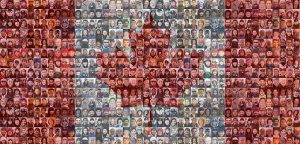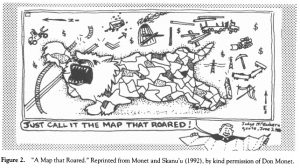Write a blog that hyper-links your research on the characters in GGRW according to the pages assigned to you. Be sure to make use of Jane Flick’s reference guide on you reading list.
I have chosen to do my research within the pages 33-43, and, with the assistance of Jane Flick’s reference guide, I will attempt to analyze several specific characters mentioned in this section.

John Wayne
“First of many references to actor famous for roles in westerns. Wayne did play one or two roles sympathetic to Indians, such as that in John Ford’s thin version of the Custer myth Fort Apache (1948); but as film historian Newman observes, Wayne came “to epitomise the Injun-hating screen cowboy,” especially after his performance in The Searchers (1956), a captivity narrative ( Wild West Movies 58). Late in his career Native Americans picketed his films. Wayne first made his name in John Ford’s Stagecoach (1939); he made many films with Maureen O’Hara, including Rio Grande (1950). Lionel’s childhood desire to be John Wayne and to have his jacket signals his denial of “Indianness.” King uses Wayne’s movie costume of leather jacket, hat and gloves to parallel George Morningstar’s “Custer” jacket, hat and gloves.” (Flick, 8)
John Wayne’s character was, essentially, used to portray a “white man” stereotype to the “Indians.” King ultimately used his character as a direct contrast to Lionel, by describing the two as polar opposites in their own rights: Where John Wayne was brave, courageous and strong, Lionel was more timid – he feared change, and because of this he struggled to escape the dreary, everyday life that he found himself living. Later on, however, he would find the courage to take action and change his life for the better; he viewed Wayne as his “hero,” and sought to follow in his footsteps. John Wayne is also one of the largest pop-culture references that King included in his story, which was, in the end, extremely effective in building rapport with his readers and allowing them to better understand what he wanted to tell them by relating directly to something that most readers would easily understand.
First Woman
“North American Indian mythology. The story of First Woman falling from the sky with the subsequent creation of Turtle Island is a common one in Seneca and other tales. The Cherokee variation involves Star Woman and is also a variant of the earth diver creation stories. Lots of fooling around with the Genesis creation story here. Note that the Lone Ranger finally gets the story off to a proper start with the mention of First Woman in Cherokee, Higayv.ligéii (15).” (Flick, 8)
First Woman represents Eve, and King chooses to paint her as somewhat of a feminist – presenting her in a more contemporary light. She dresses in clothing fitting for modern society, and eats food that we, as the readers, are all familiar with: fried chicken and apples. She is also described as having made the Garden, which shows that she had the responsibility of completing important tasks that might have been saved for only men to do in the past.
Ahdamn
“Play on Adam and the Garden of Eden story in Genesis. Note that First Woman, not God, makes the garden. See also King’s, “One Good Story, That One” for another narrative about Ahdamn and the Garden of Evening, who is First Woman. There King has the same kind of fun with Adam’s naming of creatures.” (Flick, 8)
Here, King also adds his own contemporary take on the Garden of Eden story. The important thing to note here is that King satirically describes Adamn and First Woman as being the ones to decide to leave the garden themselves, rather than being kicked out by God. By bringing this to light, King has effectively changed arguably the most well known creation story fit his own storyline, allowing readers to make less of a jump from reality to non-reality, and building off a story that readers would likely already be familiar with.
Blossom
“The setting, a town in Alberta. Blossom is also featured in King’s One Good Story, That One; see “How Corporal Colin Sterling Saved Blossom, Alberta, and Most of the Rest of the World.” The name suggests natural beauty and regeneration, as well as the smallness of the town. The name has affinities with W.O. Mitchell’s town, Crocus, Saskatchewan, in Who Has Seen the Wind? (1947). RR observes there may be a simple life-affirming message in the direction, “Blossom! Alberta.” (Flick, 8)
The name “Blossom” in itself immediately brings to mind images of beautiful flowers and nature, and a sense of relaxation and renewal. I believe that, by choosing the setting of the town of Blossom, King was emphasizing the significance of Eli Stands Alone first choosing to leave: despite Blossom being a comfortable place to be in (or perhaps, because it was so comfortable), Eli chose to leave and join the “White Man” society.
Bursum, Buffalo Bill
“King combines the names of two men famous for their hostility to Indians. Holm O. Bursum (1867-1953) was a senator from New Mexico who advocated the exploration and development of New Mexico’s mineral resources. With his eye on the map of New Mexico, he proposed the infamous Bursum Bill of 1921, which aimed to divest Pueblos of a large portion of their lands and to give land title and water rights to non-Indians. See bibliography, Washburn, HNAL The Buffalo Bill part of the name refers to William R Cody (1846-1917), an exploiter of Indians for entertainment in Buffalo Bill Cody’s Wild West Show.” (Flick, 9)
Throughout the novel, King describes Bursum to be someone who disrespected and disregarded the opinions of the First Nations people. This is demonstrated through acts such as Bursum refusing to address Minnie as “Ms. Smith,” and the contempt with which he talked about Native American culture.This way of thinking would later lead to the Bursum Bill being formed – that allowed Spanish and White farmers to exploit the land that first belonged to the First Nations.
Through all of these names of characters and places, I believe that King has done an exceptional job of relating to his readers in Green Grass, Running Water. He is able to relate to pop culture through his referencing John Wayne, whom readers would be able to identify with quite easily. King also rewrites his own take of the classic creation story of Adam and Eve through First Woman and Ahdamn, by painting both of them in a more contemporary light – much like how the two of them would likely behave if they were in our midst today. In the city of Blossom, I believe that many of us as readers have experienced, or are experiencing, our own version of Blossom. Whether we choose to leave it for something more challenging and uncomfortable, or choose to stay because of the comfort, this is a choice that I, personally, have found myself faced with. Finally, in the character of Bill Bursum, King has found a way to merge the two and portray the acts of disrespect in the past that have happened against the Native people, in this single character. As readers, we are then able to understand more clearly the significance of the Buffalo Bill and this Act as the intent and portrayal of it is personified in Bill himself. Therefore, through writing of these characters above, I believe that King has ultimately succeeded in relating to us as readers through various contemporary mediums in an attempt to help us better understand the significance of the events that have happened in Canadian history.
Works Cited
“BURSUM, Holm Olaf – Biographical Information.” BURSUM, Holm Olaf – Biographical Information. N.p., n.d. Web. 27 Jul. 2016.
Flick, Jane. “Reading Notes for Thomas King’s Green Grass, Running Water.”Canadian Literature 161-62 (1999).
King, Thomas. Green Grass Running Water. Harper Perennial. Toronto. 2007. Print








